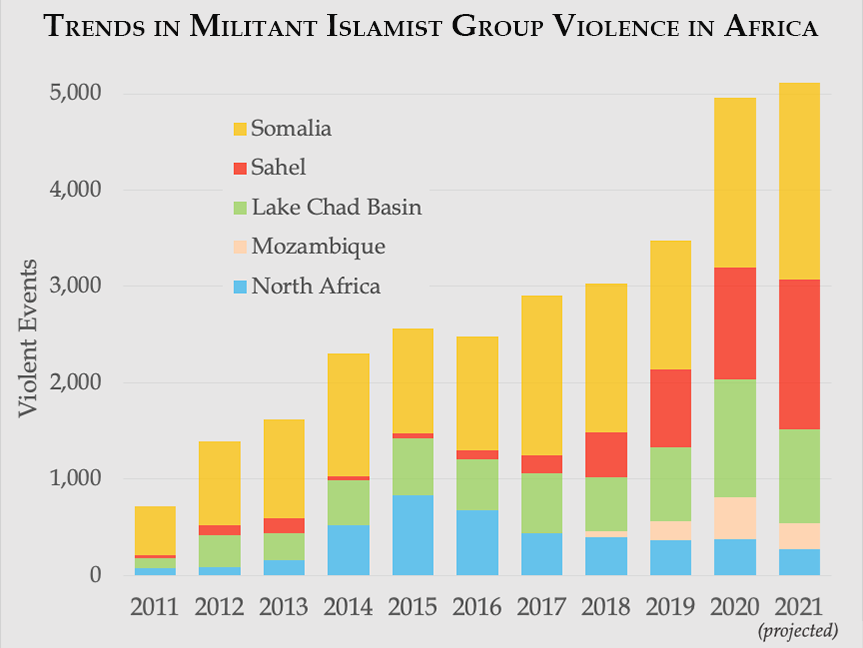The contours of African militant Islamist group violence are shifting, though maintaining a record pace of havoc resulting in an average of 14 violent events per day.
A review of mid-year data of violent episodes involving African militant Islamist groups and their evolution over the past decade underscores the growing threat posed by these actors. The threat, however, is characterized by considerable variance in levels and types of violence. Key findings include:
Militant Islamist group violence continues to be primarily concentrated in five main theaters: Somalia, the western Sahel, the Lake Chad Basin, northern Mozambique, and the Sinai Peninsula.
The projected 5,110 violent events linked to these groups in 2021 (based on mid-year data) represents a 3-percent increase from the record 4,956 violent episodes totaled in 2020. This reflects a dramatic slowing from the 43-percent increase the previous year and the average 20-percent annual increase over the preceding 4 years.
This relative leveling off in militant Islamist group activity in Africa belies stark differences in trajectories between and within the respective theaters. Nearly all the increases in violent activity are concentrated in two of the five main regions of violent extremist activity in Africa: the Sahel and Somalia. Violent activity in these areas, in turn, is closely tied to the Macina Liberation Front (FLM) in the Sahel and al Shabaab in Somalia.
Sahel
The Sahel is on track for a 33-percent rise in militant Islamist activity from 2020. This represents a relentless escalation of violent events in this region since 2016. The projected 1,552 events in 2021 would represent a 16-fold increase over that time. Notably, nearly all of this increase is being generated by the Jama’at Nusrat al Islam wal Muslimin (JNIM) coalition of militant Islamist groups, primarily FLM.
This pattern is also reflected in fatality rates. Fatalities linked to the JNIM coalition are on track to increase by 20 percent in 2021 (to over 2,400 deaths). Again, this is largely driven by FLM. Reported fatalities tied to FLM have already surpassed their 2020 level and are on track to double in 2021. Importantly, three-quarters of FLM-linked fatalities are associated with battles (with security forces and other militant groups). This reflects an ongoing trend of heightened resistance to FLM’s expansion observed since 2016.
By contrast, violence linked to the other main driver of militant Islamist group activity in the Sahel, the Islamic State in the Greater Sahara (ISGS), is on pace for a quarter fewer events and 10 percent fewer fatalities than in 2020.
Militant Islamist group violence in the Sahel is also expanding geographically over the past several years, pushing further into Burkina Faso and toward the borders with littoral states.Somalia
The Somali theater is on track for a 16-percent rise in militant Islamist events and fatalities in 2021. Al Shabaab remains the most active group in Africa and is on pace for over 2,000 violent events in 2021. This violent activity has picked up around the Somali parliamentary and presidential elections, which al Shabaab has vowed to disrupt. The increase in al Shabaab violence is also associated with a rise in battles with security forces, which is currently on pace to increase by 28 percent in 2021.
Lake Chad Basin
In the Lake Chad Basin, both Boko Haram and Islamic State in West Africa (ISWA) are experiencing a decrease in momentum. Boko Haram has seen a drop by nearly half of violent events linked to it in 2020. This is likely attributable, at least in part, to the loss of its longtime leader, Abubakar Shekau, in May 2021.
By contrast, ISWA, which has been associated with more violent events than Boko Haram since 2017, is maintaining the same pace of violent activity in 2021. Moreover, ISWA is on track for a 20-percent rise in fatalities in 2021, nearly all of which are linked to an increase in battles (with security forces and other militant groups). The rise in battles continues a trend observed since 2018.
Despite the fluctuations, fatalities linked to militant Islamist groups in the Lake Chad Basin remain comparable in scale to that seen in the Sahel and Somalia. Moreover, the death of Shekau underscores that militant Islamist activity in this theater will be highly fluid during the second half of 2021.
Mozambique
In Mozambique, Ahlu Sunnah wa Jama’a (ASWJ) is also on track for a decline in annual activity, despite the high-profile attack in Palma in March 2021. Overall, ASWJ is on pace for a third fewer violent events and fatalities compared to 2020.North Africa
North Africa continued to see a decline in militant Islamist group activity, a trend since 2015. Virtually all 134 violent events observed in North Africa in the first half of 2021 were reported in Egypt and linked to an affiliate of the Islamic State (ISIS), the Islamic State in the Sinai Province.Violence against Civilians
Data reveals a spike in violence against civilians in the Sahel. The JNIM coalition, spearheaded by FLM, has already committed more attacks on civilians in the first half of 2021 (250) than in all of 2020 (177). While ISGS is on pace for an overall drop in violent events in the first half of 2021, it has been responsible for a rise in attacks on civilians. Those attacks made up 61 percent of the violent events linked to the group. Moreover, the number of fatalities linked to ISGS’s attacks on civilians surged by 136 percent.
This trend of greater violence against civilians in the Sahel reveals a lack of public support for these militant Islamist groups and their increased reliance on intimidation to advance their parochial objectives.
